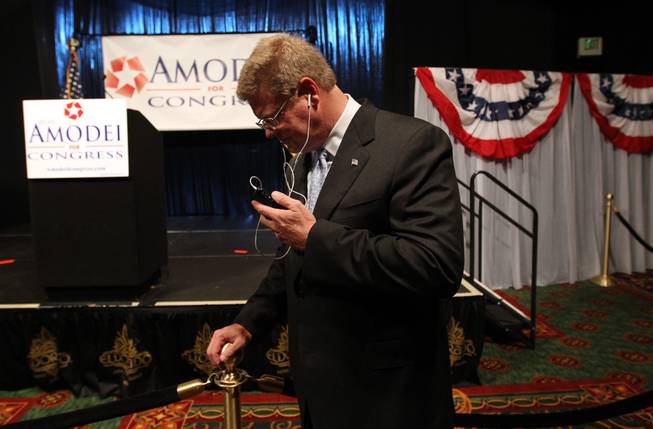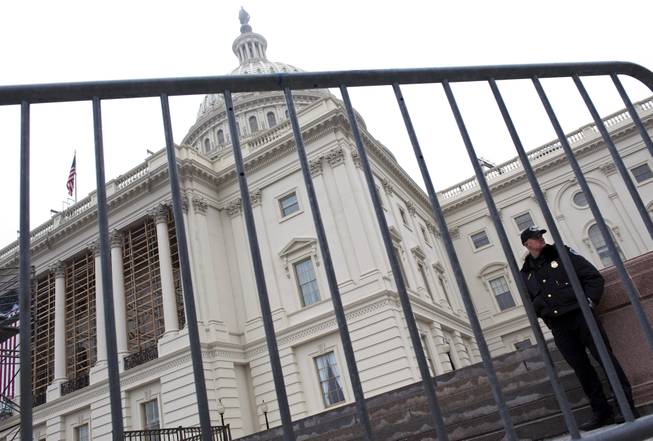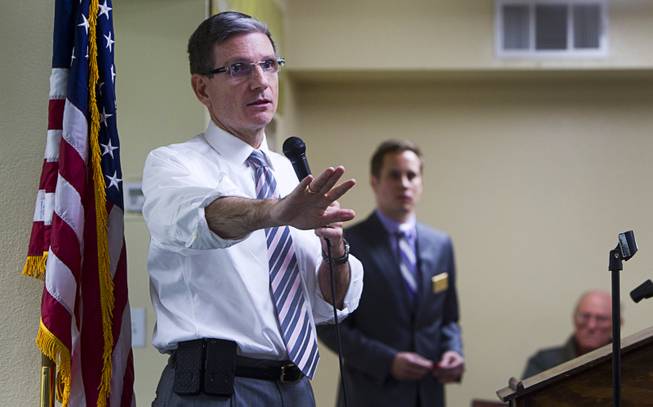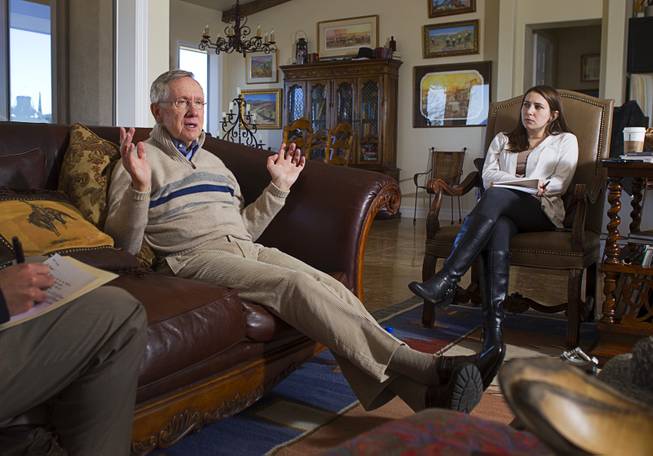
J. Scott Applewhite / AP
Members of the 113th Congress, many accompanied by family members, take the oath of office in the House of Representatives chamber on Capitol Hill in Washington, Thursday, Jan. 3, 2013.
Wednesday, March 13, 2013 | 2 a.m.
Sun coverage
Last week, Sen. Dean Heller penned a letter to the heads of the Senate Rules and Administration committee, calling for an audit of the U.S. Senate to ferret out “areas in which we can eliminate wasteful spending.”
Heller isn’t the first to suggest that in times of fiscal austerity lawmakers should lead by example: Over the past few years, the House and Senate have each voted to reduce the operating budgets for individual offices. Last year, the House functioned on about 87 percent of what it spent on salaries, administrative activities, travel and other expenses in fiscal 2010; the Senate worked with about 94 percent of its fiscal 2010 budget.
How much more in savings an audit might uncover is unclear, since, as Heller points out, the Senate has never actually engaged in a full-scale audit of its books and activities. Still, shaving even small percentages off the total congressional expenses can result in big savings since it takes almost a billion dollars per year to keep congressional offices humming.
So, what are they spending this money on anyway? While we can’t drill as deeply into the details of individual spending decisions and accounting practices across Congress as an audit might, the following slides will give a sense of just how much money goes into keeping things running in Congress, using the Nevada delegation’s books as examples.
-
The Bottom (or Top, as it were) Line
Being a member of Congress, as more than one new arrival in the Capitol has commented, is like being the CEO of your own small business. You have to manage a staff. You have to decide on company policies. And perhaps most challenging, you have to figure out how to meet all of your responsibilities while staying within an annual budget.
What that annual budget is, however, varies across chambers and across the Congress.
In the House, a Member’s Representation Allowance (MRA) varies based on how far away Washington, D.C., is from the lawmaker’s home district and how many people are in the lawmaker’s home district. While the rule of thumb is that each member of Congress represents about 711,000 constituents, that is just an average: The nonvoting delegate representing the Northern Mariana Islands’ 54,000 people gets an office and a staff on the same terms as someone like Nevada Rep. Joe Heck, who had over a million constituents in the term before redistricting.
Per-office budgets range from $1.27 million to $1.546 million. The Nevada House members whose offices responded to inquiries for this article all reported a Members’ Representational Allowances of between $1.3 million and $1.4 million per year.
The Senate’s per-member allowances also vary by the size of the state population and the distance between the home state and Washington — but at a higher level. Last year, Senators’ Official Personnel and Office Expense Accounts ranged from $2.96 million to $4.65 million. In the last fiscal year, Heller’s office and Sen. Harry Reid’s personal office were each allotted slightly over $3 million.
As majority leader, Reid is also entitled to additional accounts. His duties as majority leader and chair of the Senate Democratic Conference Committee cost about $4.5 million. Some, but not all, of that pays for staffers who split their time working on national and Nevada issues.
-

Salaries — Lawmakers
Once upon a time, back around the birth of the nation, lawmakers got a $6 per diem for every day Congress was in session. That’s about $80 in today’s dollars. Today, being an ordinary member of Congress commands a salary of $174,000 per year. That holds true whether one is in the House or the Senate, unless the member happens to be in a position that carries extra job responsibilities. Reid makes $193,400, like all the other party leaders; House Speaker John Boehner commands the highest salary, at $223,500.
-
The Benefits
One often hears about how the best part of a government job is the government benefits. Although many federal employees might beg to disagree, there are a number of benefits that come along with a congressional office.
First and foremost is health care — comprehensive insurance packages are available to anyone who wants them, on a voluntary basis that involves individual contributions. Lawmakers are also entitled to life insurance, retirement benefits and pensions that begin to vest after five years of service in Congress.
But there are also perks to be enjoyed that go beyond the ordinary employee’s benefits. For example: For all that cross-continental living, members get a special tax deduction for living expenses — up to $3,000 per year.
-
Salaries — Everyone Else
Lawmakers’ salaries are the only ones that don’t come out of the per-office kitty. Staff salaries are the largest expenditure for any entity in Congress, whether a policy committee, administrative office or congressional lawmaker’s outfit.
In the Nevada delegation, that was definitely the case: In fiscal 2012, every lawmaker but Rep. Mark Amodei spent well over half of his or her office budget on payroll.
There are a few rules, though, about how much lawmakers can spend on their staff and how they can spend it.
In the House, lawmakers can’t hire more than 18 full-time employees — with a special allowance for an extra four part-timers, temps or paid interns. Additionally, none of those full-time employees can receive a salary of more than $168,411. Senators, meanwhile, don’t have such limits — though committee staffers can’t be paid more than $171,315.
-

Rent
The next biggest expenditure in a congressional budget is usually the cost of maintaining offices on the home turf. Lawmakers can spend as much of their allotted budget as they want on rent for office space — they’re encouraged to seek out space in federal buildings but are allowed to spend the going General Services Administration rate on digs of up to about 5,000 square feet in a low-population state such as Nevada. They can also use funds to buy furniture for the offices outside of Washington, D.C.
In D.C., the office comes with the territory, and lawmakers are supposed to decorate by picking and choosing from the copious amounts of chairs, couches, desks, shelves and cabinets that the House and Senate administrative offices keep, refurbish and distribute among the offices. Computers, mobile phones and other electronic equipment are also handled centrally in the House and Senate.
Last year, Heller spent a little over $220,000 and Reid spent about $170,000 on office space in Nevada. House administrators budgeted about $256,574 for office expenses, but Nevada lawmakers didn’t actually spend anywhere near that much: In fiscal 2012, the biggest rental expense was borne by Rep. Joe Heck, who paid a total of $118,774 on office space and related costs, according to his expense reports.
-

Staying Close, Staying in Touch
You can’t represent your constituents if you can’t communicate with them. Part of each lawmaker’s budget is intended to pay for the costs of staying in touch, whether by plane, train, automobile or simply sending a letter. How much lawmakers are reimbursed for their travel costs is determined on a cost-per-mile reimbursement system, where the distance between a lawmaker’s home district and Washington, D.C., determines the reimbursement rate.
For most Nevada representatives, the reimbursement rate used to calculate estimated travel budgets was $0.43 per mile; for representatives of the First Congressional District, it would have been $0.48. Nevada lawmakers spent anywhere from $28,078 to $147,769 on official travel in fiscal 2012, with former Rep. Shelley Berkley at the bottom end of the spectrum (since most of her travel was for campaign, not official, purposes) and Sen. Harry Reid at the highest end.
There are also special expense categories for printing and “franking” costs — that being how much it costs lawmakers to post mailings to constituents back at home. Heck made a few headlines last year for having one of the highest snail mail budgets in Congress: Heck spent over $300,000 on printing, postage and related costs while other offices spent less than half that much. But he still came in slightly under the office budget of $1.4 million, spending $1,315,814 during fiscal 2012, according to expenditure reports.
-

Giving Back
Since budgets are fixed, lawmakers go to different lengths to make sure they spend within their limits — and usually end up turning some money back into the congressional coffers at the end of the year. Earlier this year, Amodei made a big show of returning $155,000 in unspent 2012 funds to the Treasury — certainly more than other members of the House returned. At the close of fiscal 2012, both Reid and Heller appeared to have several hundred thousand dollars each left unspent.
A learned habit of coming in under budget is especially important this year, when congressional offices, like most other entities of the federal government, are staring down a potentially significant era of belt-tightening with the sequester. According to Greg Lemon, a spokesman for Heck, House offices were told to brace for as much as an 8 percent budget squeeze.
All members of the Nevada delegation who responded to inquiries for this article said that they are spending with the assumption that the sequester will kick in. That goes for the new offices, such as Rep. Steven Horsford’s, too — even though as a new representative in a new district, almost every expense goes toward starting from scratch.
-

Everything Else
With a little quick multiplication, it’s clear the numbers broken down here cannot possibly account for the full cost of running Congress. The salaries of Capitol security, administrative support staff, service workers, subway operators and the congressional chaplains aren’t included as line items on a lawmaker’s budget, though they may well help to keep the cost of individual offices’ personnel and travel expenses down.
In total, House expenses in calendar 2012 came to $1.26 billion while Senate expenses in fiscal 2012 came to $931 million. Senate reports are filed with the secretary of the Senate while House disbursements are filed with the Chief Administrative Officer of the House.









Join the Discussion:
Check this out for a full explanation of our conversion to the LiveFyre commenting system and instructions on how to sign up for an account.
Full comments policy